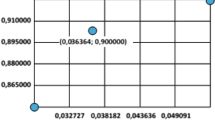Abstract
A new mathematical formulation for the constitutive laws governing elastic perfectly plastic materials is proposed here. In particular, it is shown that the elastic strain rate and the plastic strain rate form an orthogonal decomposition with respect to the tangent cone and the normal cone of the yield domain. It is also shown that the stress rate can be seen as the projection on the tangent cone of the elastic stress tensor. This approach leads to a coherent mathematical formulation of the elasto-plastic laws and simplifies the resulting system for the associated flow evolution equations. The cases of one or two yield functions are treated in detail. The practical examples of the von Mises and Tresca yield criteria are worked out in detail to demonstrate the usefulness of the new formalism in applications.
Similar content being viewed by others
References
Anzellotti, G., Luckhaus, S.: Dynamical Evolution of Elasto-Perfectly Plastic Bodies. Appl. Math. Optim. 15, 121–140 (1987)
Babadjian, J.-F., Crismale, V.: Dissipative boundary conditions and entropic solutions in dynamical perfect plasticity. Journal de Mathématiques Pures et Appliquées 148, 75–127 (2021)
Borwein, J., Lewis, A.S.: Convex Analysis and Nonlinear Optimization, 2nd edn. Springer, Berlin (2006)
Boulmezaoud, T. Z. , Khouider, B.: Some mathematical observations on plasticity, in preparation
Bauschke, H.H., Combettes, P.L.: Convex Analysis and Monotone Operator Theory in Hilbert Spaces. Springer, Berlin (2010)
M. Coon, M., Maykut, G., Pritchard, R., Rothrock, D., Thorndlike, A.: Modeling the Pack Ice as an Elastic-plastic Material, AIDJEX Bulletin, vol. 24 (1974)
Dal Maso, G., DeSimone, A., Mora, M.G.: Quasistatic evolution problems for linearly elastic-perfectly plastic materials. Arch. Rational Mech. Anal. 180, 237–291 (2006)
Daniilidis, A., Lewis, A.S., Malick, J., Sendov, H.: Prox-regularity of spectral functions and spectral sets. J. Convex Anal. 15, 547–560 (2008)
Drucker, D.C.: The relation of experiments to mathematical theories of plasticity. J. Appl. Mech., Trans. ASME 16, 349–357 (1949)
Drucker, D. C.: A more fundamental approach to plastic stress-strain relations. In: Proc. 1st U.S. Nat. Congr. Appl. Mech. (1951), p. 487
Duvaut, G., Lions, J.-L.: Inequalities in Mechanics and Physics, Dunod, Paris, (1972, in French) and Springer-Verlag (1976, in English)
Fuchs, M., Seregin, G. : Variational methods for problems from plasticity theory and for generalized Newtonian fluids. Lecture Notes in Mathematics book series, Vol. 1749, Springer (2000)
Gao, Y., Strang, G.: Dual extremum principles in finite elastoplastic deformation. Acta Appl. Math. 17, 257–268 (1989)
Han, W., Reddy, B.D.: Plasticity, Interdisciplinary Applied Mathematics book series, vol. 9. Second edition, Springer, Berlin (2013)
Hashiguchi, K., Ueno, M., Ozaki, T.: Elastoplastic model of metals with smooth elastic-plastic transition. Acta Mechenica 223, 985–1013 (2012)
Hibler, W.: A dynamic thermodynamic sea ice model. J. Phys. Oceanogr. 9, 815–846 (1979)
Hill, R.: A variational principle of maximum plastic work in classical plasticity. Q. J. Mech. Appl. Math. 1, 18–28 (1928)
Hill, R.: The mechanics of quasi-static plastic deformation in metals. Survey in Mechanics, Cambridge (1956)
Hill, R.: The Mathematical Theory of Plasticity. Clarendon Press, Oxford (1950)
Horn, R.A., Johnson, Ch.R.: Matrix Analysis. Cambridge University Press, Cambridge (1989)
Hiriart-Urruty, J.-B., Lemaréchal, C.: Fundamentals of Convex Analysis. Springer, Berlin (1993)
Jarre, F.: Convex Analysis on Symmetric Matrices. In: Wolkowicz, H., Saigal, R., Vandenberghe, L. (eds.) Handbook of Semidefinite Programming. International Series in Operations Research & Management Science, vol. 27, pp. 13–27. Springer, Boston (2000)
Johnson, C.: Existence theorems for plasticity problems. J. Math. Pure Appl. 55, 431–444 (1976)
Koiter, W.T.: Stress-strain relations, uniqueness and variational theorems for elastic-plastic material with a singular yield surface. Q. Appl. Math. 11(3), 350–354 (1953)
Koiter, W. T.: General theorems for elastic-plastic solids. In: Sneddon, I.N., Hill, R. (eds.) Progress in Solid Mechanics, Vol. 1, pp. 167–221 (1960)
Lewis, A.S.: Convex analysis on the Hermitian matrices. SIAM J. Optim. 6, 164–177 (1996)
Lode, W.: Versuche über den Einflußder mittleren Hauptspannung auf das Fließen der Metalle Eisen Kupfer und Nickel, Metalle Eisen Kupfer und Nickel. Z. Phys. 36, 913–936 (1926)
Lubliner, J.: Plasticity Theory. Macmillan Publishing Company, New York (1970)
Moreau, J. J.: Application of convex analysis to the treatment of elastoplastic systems, dans applications of methods of functional analysis to problems of mechanics. In: Germain, P., Nayroles, B. (eds.) Lecture Notes in Math., Vol. 503, Springer-Verlag, pp. 56–89 (1976)
Strang, G.: Recent contributions to plasticity theory. J. Franklin Inst. 302, 429–442 (1977)
Strang, G.: A minimax problem in plasticity theory. In: M.Z. Nashed (ed.) Functional Analysis Methods in Numerical Analysis, Springer Lecture Notes 701, pp. 319–333 (1979)
Strang, G., Temam, R.: Duality and relaxation in the variational problems of plasticity. J. de Mécanique 19, 1–35 (1980)
Suquet, P.-M.: Un espace fonctionnel pour les équations de la plasticité, Annales de la Faculté des sciences de Toulouse : Mathématiques, Série 5. Tome 1(1), 77–87 (1979)
Suquet, P.-M.: Sur les équations de la plasticité: existence et régularité des solutions. Journal de Mécanique, Vol. 20, No. 1 (1981)
Suquet, P.-M.: Evolution problems for a class of dissipative materials. Q. Appl. Math. 38, 391–414 (1981)
Swedlow, J.L., Cruse, T.A.: Formulation of boundary integral equations for three-dimensional elasto-plastic flow. Int. J. Solids Struct. 7(12), 1673–1683 (1971)
Temam, R.: Mathematical Problems in Plasticity, Dunod, Paris, 1983 (in French), and Gauthier-Villars, Paris-New York, 1984 (in English)
Temam, R.: A generalized Norton-Hoff Model and the Prandtl-Reuss Law of Plasticity. Arch. Ration. Mech. Anal. 95, 137–183 (1986)
Tresca, H.: Mémoire sur l’écoulement des corps solides soumis à de fortes pressions. C. R. Acad. Sci. Paris 59, 754 (1864)
Von Mises, R.: Mechanik der plastischen Formaenderung von Kristallen. Z. Angew. Math. Meek 8, 161–185 (1928)
Yu, H.S.: A closed-form solution of stiffness matrix for Tresca and Mohr-Coulomb plasticity models. Comput. Struct. 53(3), 755–757 (1994)
Acknowledgements
This work has been conducted in 2020–2021 when T. Z. B. was a visiting professor at the University of Victoria. This visit is funded by the French Government through the Centre National de la Recherche Scientifique (CNRS)-Pacific Institute for the Mathematical Sciences (PIMS) mobility program. The research of B. K. is partially funded by a Natural Sciences and Engineering Research Council of Canada Discovery grant.
Author information
Authors and Affiliations
Corresponding author
Additional information
Publisher's Note
Springer Nature remains neutral with regard to jurisdictional claims in published maps and institutional affiliations.
Appendix A: Proof of Lemma 4.7
Appendix A: Proof of Lemma 4.7
Obviously, \(W_{m, i} \in G_m({\varvec{\sigma }})\) for \(1 \leqslant i \leqslant 3\). Furthermore, one can easily show that for \(i \ne m\) and \(j \ne m\)
Furthermore, let \({\varvec{\kappa }}\in G_m({\varvec{\sigma }})\). Since \({\varvec{\kappa }}v_m({\varvec{\sigma }})= 0\), 0 is an eigenvalue of \({\varvec{\kappa }}\). Let \(\{u_1, u_2, v_3\}\) be an orthonormal basis of eigenvectors of \({\varvec{\kappa }}\). We have the spectral decomposition
On the other hand,
Thus, for each \(i \leqslant 2\) there exist real numbers \(\alpha _i, \beta _i\) such that \(u_i = \alpha _i v_1 + \beta _i v_2\). It follows that
We conclude that \(\{W_1, W_2, W_3\}\) is an orthonormal basis of \(G_m({\varvec{\sigma }})\).
Rights and permissions
Springer Nature or its licensor (e.g. a society or other partner) holds exclusive rights to this article under a publishing agreement with the author(s) or other rightsholder(s); author self-archiving of the accepted manuscript version of this article is solely governed by the terms of such publishing agreement and applicable law.
About this article
Cite this article
Boulmezaoud, T.Z., Khouider, B. A new mathematical formulation of the equations of perfect elasto-plasticity. Z. Angew. Math. Phys. 73, 246 (2022). https://doi.org/10.1007/s00033-022-01863-0
Received:
Revised:
Accepted:
Published:
DOI: https://doi.org/10.1007/s00033-022-01863-0
Keywords
- Elasto-plasticity
- Constitutive laws
- Convexity
- von Mises criterion
- Tresca criterion
- Elasto-plastic waves
- Normal and tangent cones




